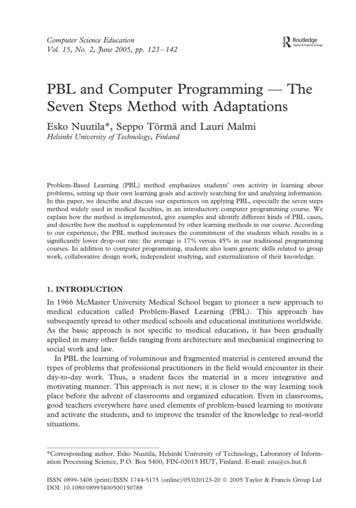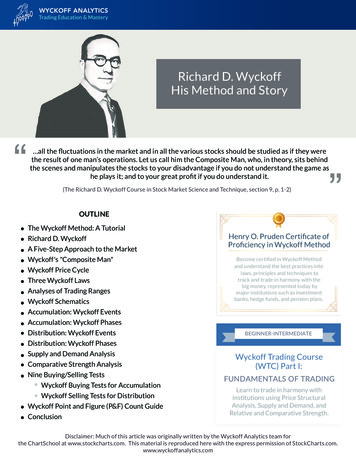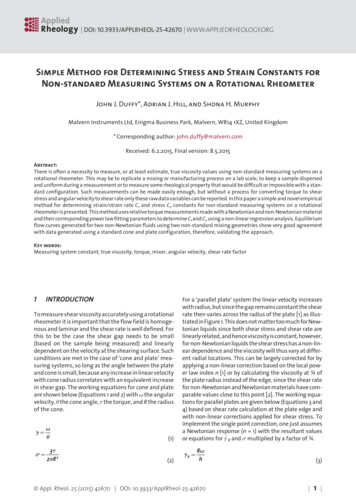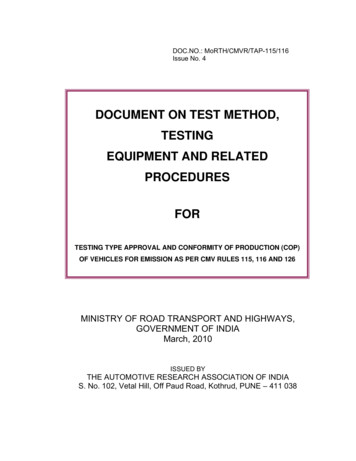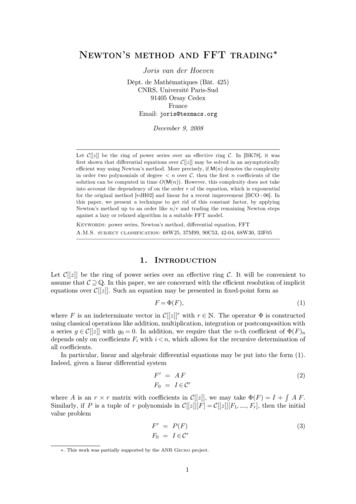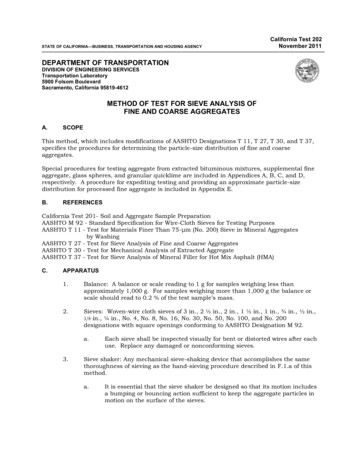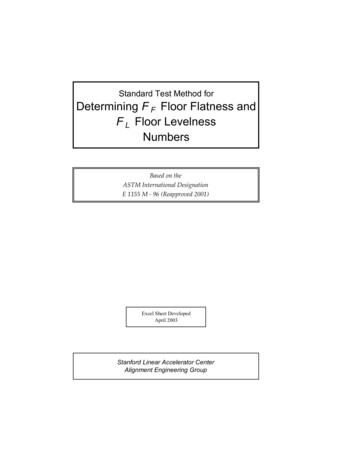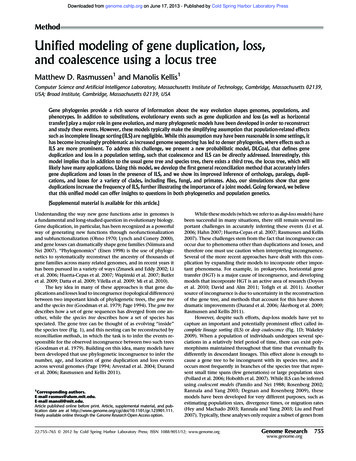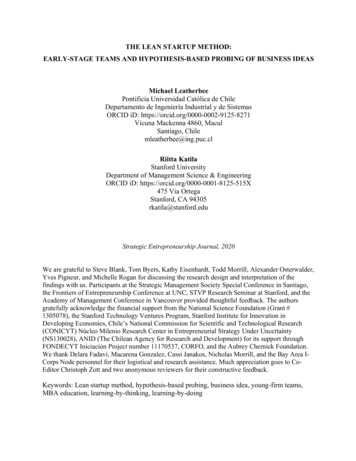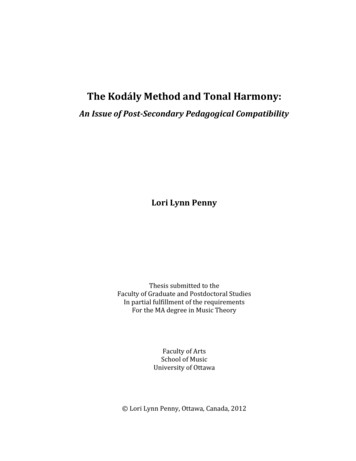
Transcription
The Kodály Method and Tonal Harmony:An Issue of Post-Secondary Pedagogical CompatibilityLori Lynn PennyThesis submitted to theFaculty of Graduate and Postdoctoral StudiesIn partial fulfillment of the requirementsFor the MA degree in Music TheoryFaculty of ArtsSchool of MusicUniversity of Ottawa Lori Lynn Penny, Ottawa, Canada, 2012
iiTable of ContentsAbstractAcknowledgementsviiviiiChapter 1: Introduction and Literature Review, Context and MethodologyOpening Remarks1A Review of Pertinent Literature2Journal of Music Theory PedagogyRogers: Teaching Approaches in Music TheoryThompson: A History of Harmonic Theory in the United StatesWhite: Guidelines for College Teaching of Music TheoryThe Kodály MethodAn Educational PhilosophyThe Tools and MaterialsA Child-Developmental SequenceA North-American AdaptationThe Theoretical FrameworkAn Instructional ProcessA Specific Teaching StrategyAn Outline of Subsequent Chapters335677891011111215Chapter 2: Empirical ComponentIntroductory RemarksA Personal PerspectiveThe RationaleThe InterviewsA MethodologyThe Data Collection and DescriptionThe Case-Study FindingsA Discussion of Case-Based ThemesConcluding Remarks161616171718232529
iiiChapter 3: Application and AnalysisIntroductory Remarks31Aldwell and Schachter: Harmony and Voice Leading32A Conceptual SequenceThe PresentationMusical ExcerptsThe ReviewsClendinning and Marvin: The Musician’s Guide to Theory and AnalysisA Conceptual SequenceThe PresentationMusical ExcerptsThe ReviewsGauldin: Harmonic Practice in Tonal MusicA Conceptual SequenceThe PresentationMusical ExcerptsThe ReviewsKostka and Payne: Tonal HarmonyA Conceptual SequenceThe PresentationMusical ExcerptsThe ReviewsRoig-Francoli:Harmony in ContextA Conceptual SequenceThe PresentationMusical ExcerptsThe 998100Chapter 4: ComparisonA Comparison of Textbooks101Conceptual SequencesPresentationsMusical Excerpts101107115A Comparison with Kodály’s MethodologyPreparationConscious AwarenessReinforcementAssessment118119120121124
ivChapter 5: Synthesis and ConclusionSynthesis of Kodály’s Methodology and Tonal Harmony126The ImplicationsThe LimitationsFuture Inquiries126130131Concluding Remarks132AppendicesAppendix A: Consent FormAppendix B: Interview QuestionsBibliography134136137
vList of ExamplesExample 1.1: Cherubini, “Solmization,” Dominant-Seventh Chord (Make Conscious)13Example 1.2: Newfoundland Traditional Folk Song, “We’ll Rant and We’ll Roar,”Dominant-Seventh Chord (Reinforce)14Example 1.3: Beethoven, Symphony No. 6, Fifth Movement, Principal Theme,Dominant-Seventh Chord (Assess)15Example 3.1: Seventh Chord (Melodic Origin)35Example 3.2: Haydn, Symphony No. 97, Third Movement, Dominant-Seventh Chord(Introduction)41Example 3.3: Schubert, Impromptu, D. 935, Inversions of the Dominant-Seventh Chord(Introduction)42Example 3.4: Rodgers and Hart, “My Funny Valentine,” Seventh Chords (Flexible Doublings)55Example 3.5: Mozart, Piano Sonata in C Major, K. 545, Second Movement,Inversions of the Dominant-Seventh Chord (Tonic Prolongation)57Example 3.6: Mozart, Symphony No. 39 in E-flat Major, Third Movement (Simplified),Dominant-Seventh Chord (Harmonic Elaboration)65Example 3.7: Sousa, “The Thunderer,” Inversions of the Dominant-Seventh Chord(Dominant Prolongation)72Example 3.8: Tonal Harmony (Functional Tendency)77Example 3.9: Bach, “Nun ruhen alle Wälder,” Dominant-Seventh Chord(Resolution and Approach)85Example 3.10: Willson, “I Ain’t Down Yet,” Dominant-Seventh Chord (Linear Tendency)91Example 3.11: Mozart, Concerto in E-flat Major for Horn and Orchestra, K. 447,Second Movement, Dominant-Seventh Chord (Inversion)94
viList of TablesTable 3.1: Summary of Musical Excerpts in Relation to the Dominant-Seventh Chord(Inversions)43Table 3.2: Dissonant Intervals of the Dominant-Seventh Chord (Resolutions)50Table 3.3: Summary of Musical Excerpts in Relation to the Dominant-Seventh Chord56Table 3.4: Summary of Musical Excerpts in Relation to the Dominant-Seventh Chord70Table 3.5: Summary of Musical Excerpts in Relation to the Dominant-Seventh Chord(Inversions)71Table 3.6: Summary of Musical Excerpts in Relation to the Dominant-Seventh Chord(Resolutions)83Table 3.7: Summary of Musical Excerpts in Relation to the Dominant-Seventh Chord(Approaches)84Table 3.8: Summary of Musical Excerpts in Relation to the Dominant-Seventh Chord99Table 4.1: Summary of Preparatory Concepts in Relation to the Study of Tonal Harmony(Seventh Chords)102Table 4.2: Summary of Conceptual Experiences in Relation to the Dominant-Seventh Chord(Preparation)104Table 4.3: Summary of Conceptual Experiences in Relation to the Dominant-Seventh Chord(Presentation)108Table 4.4: Comparison of Conceptual Experiences in Relation to the Initial Presentationof the Dominant-Seventh Chord (Root Position)111Table 4.5: Comparison of Conceptual Experiences in Relation to the Initial Presentationof the Dominant-Seventh Chord (Inversions)113Table 4.6: Comparison of Musical Excerpts in Relation to the Initial Presentationof the Dominant-Seventh Chord (Composers and Genres)116Table 4.7: Comparison of Reinforcement Exercises in Relationto the Dominant-Seventh Chord122Table 4.8: Summary of Musical Excerpts in Relation to the Dominant-Seventh Chord(Reinforcement Exercises)123Table 4.9: Summary of Creative Activities in Relation to the Dominant-Seventh Chord(Assessment Exercises)125
viiAbstractThis study explores the topic of music theory pedagogy in conjunction with the Kodály concept ofmusic education and its North-American adaptation by Lois Choksy. It investigates the compatibilityof the Kodály Method with post-secondary instruction in tonal harmony, using a theoreticalframework derived from Kodály’s methodology and implemented as a teaching strategy for thedominant-seventh chord. The customary presentation of this concept is authenticated with anempirical case study involving four university professors. Subsequently, Kodály’s four-stepinstructional process informs a comparative analysis of five university-level textbooks that evaluatesthe sequential placement of V7, examines the procedure by which it is presented, and considers theinclusion of correlated musical excerpts. Although divergent from traditional approaches to tonalharmony, Kodály’s principles and practices are pedagogically effective. By progressing fromconcrete to abstract, preceding symbolization with extensive musical experience, conceptualunderstandings are not only intellectualized, but are developed and internalized.Keywords: music theory pedagogy, the Kodály Method, Zoltán Kodály, Lois Choksy, Edward Aldwell,Carl Schachter, Harmony and Voice Leading (2003), Jane Piper Clendinning, Elizabeth West Marvin,The Musician’s Guide to Theory and Analysis (2005), Robert Gauldin, Harmonic Practice in TonalMusic (2004), Stefan Kostka, Dorothy Payne, Tonal Harmony (2004), Miguel Roig-Francolí, Harmonyin Context (2003)
viiiAcknowledgementsThis manuscript is a testament to the wisdom of Professors Allan Bell (Music Theory) and LoisChoksy (Music Education). Intermingled with the passage of time, their teachings have shaped mypersonal philosophy and informed my practice as a music theory educator. But their inspirationwould not have taken its present form without the persuasion of my friend and colleague, AnnBabin. Ann’s timely suggestion ignited the spark of possibility, and her own mid-life studies servedas a motivating incentive. Once my post-graduate journey began, I received endlessencouragement and support from my colleagues – members of the Gloucester Music Teachers’Association (GMTA); the Ottawa Region Branch of the Ontario Registered Music Teachers’Association (ORMTA); the College of Examiners for the Royal Conservatory of Music (RCM); as wellas my student colleagues at the University of Ottawa (School of Music).Each of my professors contributed to the formulation of my research intentions: Dr. RoxanePrevost provided an organized framework for my fledgling ideas; Dr. Christopher Moorestrengthened my argument with his circular questioning; Dr. Julie Pednault-Deslauriers promptedme to think independently; Dr. Murray Dineen convinced me to reach beyond my perceivedlimitations; Dr. John Armstrong fueled my confidence with his academic acceptance; and Dr.Barbara Graves introduced me to a narrative style of writing. I am indebted to the members of mycommittee – Dr. Bernie Andrews, Dr. Gilles Comeau, and Dr. Murray Dineen – for reading mymaterials and providing constructive feedback. My deepest appreciation, however, is extended tomy advisor, Dr. Roxane Prevost. Dr. Prevost’s sensitive leadership both nurtured and stimulated myexploration of music theory pedagogy – a topic she was willing to embrace, despite its relativeobscurity in the scholarly literature. Our meetings became treasured opportunities for me toverbalize my thoughts, enabling them to grow and mature. She listened, considered, commented,
ixand advised, supplying me with the energy and momentum to move forward. A document of thismagnitude would not have been imaginable without her counsel.I am profoundly grateful to my family for allowing me to become more than a daughter, sister,wife, and mother. From my parents, Larry and Noreen Trekofski, I learned the value of persistenceand hard work. My brothers, who live in Australia (Byron) and China (Darwin), opened my eyes tothe world and demonstrated for me that life is what we make of it. This sentiment is shared by myextraordinary husband, Keith Penny, who lovingly indulged my penchant for projects. In manyrespects, my thesis became a joint endeavour – our most ambitious to date. I wish to thank him forhis patience and understanding, his technical support, and his practical advice. Our children, whosenames gave voice to my case-study participants (Afton Ford, Amalia Caza, Aris Donavan, and AjaChisholm), offered me a constant flow of reinforcement and assistance. I hope that my graduateexperience will foster for them a life-long love of learning, and provide them with the courage topursue their own dreams.Finally, this manuscript is dedicated to Elaine Kruse, my dear colleague, mentor, and friend,whose untimely passing altered the course of my professional career. Her gentle guidance ispalpable even now.
1Chapter 1:Introduction and Literature Review,Context and MethodologyOpening RemarksThe topic of my research may be likened to a seed planted more than twenty-five years ago, as Icompleted my undergraduate studies in elementary school music. It rose to the surfaceapproximately five years later, inspired by a diploma program specializing in the Kodály concept ofmusic education, only to recede without an opportunity to take root. Asserting a quietdetermination, that tiny seed has finally encountered favourable conditions and begun to grow. Atissue is a question of compatibility: are the pedagogical principles attributed to Zoltán Kodály (18821967) congruent with teaching tonal harmony at a post-secondary level?My research, motivated by a desire to improve the learning experience of my music theorystudents, will outline the basic precepts of Kodály’s educational philosophy and its North-Americanadaptation by Lois Choksy (Emerita, University of Calgary). Referencing Choksy’s publications, I willconstruct a long-range teaching strategy involving the dominant-seventh chord as a sampleconceptual element. From this illustrative example, I will extract a theoretical framework andemploy it as a comparative model in the analysis of five university-level textbooks on tonalharmony.The textbooks I will analyse are: Aldwell and Schachter, Harmony and Voice Leading, 3rd edition (2003)Clendinning and Marvin, The Musician’s Guide to Theory and Analysis (2005)Gauldin, Harmonic Practice in Tonal Music, 2nd edition (2004)Kostka and Payne, Tonal Harmony, 5th edition (2004)Roig-Francolí, Harmony in Context (2003)
2Specific editions have been chosen with similar publication dates, although Aldwell and Schachter,Clendinning and Marvin, Kostka and Payne, as well as Roig-Francolí, have subsequently producedrevised texts.Considering a diatonic context, I will examine each textbook’s instructional treatment of thedominant-seventh chord, observing three criteria. I will: evaluate its placement in a conceptual sequencedetermine the procedure by which it is presentedinvestigate the inclusion of correlated musical excerptsI will also search for the pedagogical components of the Kodály Method, and using my comparativemodel, I will explore an inclusive approach to the introduction of the dominant-seventh chord,proposing the implementation of a Kodály-centred methodology for the presentation oftheoretical concepts.In the remainder of this chapter, I will review the scholarly literature that pertains to the topicof music theory pedagogy and introduce the Kodály Method, addressing the educationalphilosophies that define Kodály’s pedagogical principles, the tools and materials that facilitate itsimplementation, and Choksy’s North-American adaptation of its methodology. Further, I willpropose a theoretical framework, derived from Kodály’s instructional process, which will inform theanalytical portion of my research.A Review of Pertinent LiteratureThe development of music theory pedagogy as an independent discipline is documented byRobert Gauldin (Emeritus, Eastman School of Music) and Mary Wennerstrom (Indiana University) ina special issue of Music Theory Spectrum (Spring 1989), which, along with a survey of relevantresearch, includes a selected bibliography. Under the heading “General Sources” (p. 69), only fourreferences are cited:
3 Journal of Music Theory Pedagogy (1987 - present)Rogers, Teaching Approaches in Music Theory: An Overview of PedagogicalPhilosophies (1984)Thompson, A History of Harmonic Theory in the United States (1980)White, Guidelines for College Teaching of Music Theory (1981)While the offerings of both
Kostka and Payne, Tonal Harmony, 5th edition (2004) Roig-Francolí, Harmony in Context (2003) 2 Specific editions have been chosen with similar publication dates, although Aldwell and Schachter, Clendinning and Marvin, Kostka and Payne, as well as Roig-Francolí, have subsequently produced revised texts. Considering a diatonic context, I will examine each textbooks instructional treatment of .

